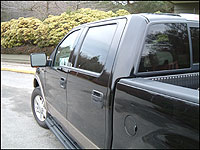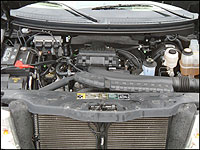2004 Ford F150 4x4 Crew-Cab Lariat
3-21-2004
by
Rob Rothwell
, Canadian Auto Press
|
For such a large vehicle, very little body-flex or reverberation penetrates the vault-like cabin when broken pavement or washboard surfaces are encountered. Although not car-like, the Lariat's well-controlled ride is most impressive. Road irregularities are reduced to jiggles when passing beneath the 18-inch all-terrain tires and wheels - standard equipment on the Lariat model by the way. This exemplary ride quality is achieved with the use of a coil-over-shock, double wishbone front suspension, combined with leaf springs and outboard shock absorbers holding up the rear. Also worthy of praise is the truck's ability to heavily-mute road noise, especially when its electronically activated, 4-wheel drive hardware and aggressive tire treads are factored into the equation.
 |
| Although not car-like, the Lariat's well-controlled ride is most impressive. (Photo: Rob Rothwell, Canadian Auto Press) |
Motivating either two or four of the truck's big wheels will be one of a pair of available V8s. The base engine is a 4.7-liter, 16-valve SOHC V8 that twists out 231 horsepower and 293 lb-ft of torque. The premium powerplant, which is based on Ford's modular engine technology, displaces 5.4-liters, ratcheting up horsepower and torque to 300 and 365 respectively. This all-new SOHC power source features three-valves per cylinder and aluminum cylinder heads. It's also Ford's first modular V8 to use variable valve timing, which is a technology that enables the timing of valve openings and closings to advance with an increase in engine speed, resulting in increased power and efficiency.
 |
| The big truck is available with two different V8 engines, a base 4.7-liter unit and a 5.4-liter. (Photo: Rob Rothwell, Canadian Auto Press) |
On the road, the variable valve timing technology is imperceptible to most. What isn't so benign is the increased torque of the rev-happy Triton engine. Although I have not driven the 4.6-liter Triton V8, I can certainly attest to the smooth and refined characteristics of its 5.4-liter sibling. This engine is a pleasure to master. It quietly delivers power through a torque-based electronic throttle control system that uses driver input from the accelerator pedal to actively modulate the torque at the drive wheels. Ford claims this fly-by-wire technology "provides consistently seamless throttle response." Acceleration is definitely good for this size of a vehicle. Jackrabbit starts and authoritative highway passing are easily accomplished, and with very little fuss or need to push the 5.4 to its limit. |
|
|

